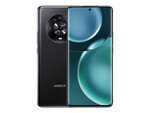Honor Magic4 5G
Ausstattung / Datenblatt

Secondary Camera: 12 MPix f/2.4, 1.22µm
Preisvergleich
Testberichte für das Honor Magic4 5G
Quelle: OI Spice Tech News
 EN→DE
EN→DEThe much-needed improvements in the camera, processor, display, and battery give the Honor Magic 4 and 4 Pro smartphones an incredible value in the flagship market. If you want a flagship smartphone with incredible cameras, then you can’t go wrong with either of these two smartphones. Both the smartphones will provide an excellent flagship experience but if you want a slight edge in the display, camera, charging capabilities, and water resistance, then the Honor Magic 4 Pro model makes more sense. Considering the specs and the experience the phone provides, the price of both smartphones is justified. But if want an alternative to compare before you make your decision, then the Samsung Galaxy S22 Ultra is quite the competitor and can go toe to toe with the new Magic 4 and Magic 4 Pro series.
Vergleich, online verfügbar, Mittel, Datum: 17.04.2022
Quelle: OI Spice Tech News
 EN→DE
EN→DEHonor Magic 4 is the latest 5G smartphone that arrives in the premium segment at the price of around $995 (Rs 75,990 in India) approx. The phone got released in March 2022 that equips a 6.81 inches LTPO OLED display panel with a 120Hz refresh rate and 1000 nits peak brightness. The honor magic 4 phone renders on the latest Android 12 OS with the Magic UI 6 user interface. For performance a 4nm Qualcomm Snapdragon 8 Gen 1 chipset powers the device and can reach up to a max of 3GHz clocking speed. The Honor Magic 4 is available in 8GB/12GB RAM with 128GB/256GB/512GB internal storage. A triple rear camera is provided in the magic 4 smartphones where a 50MP main lens, 50MP ultrawide, and an 8 MP periscope telephoto lens can record 4K videos up to 60fps. On the front side, you get a 12 MP ultrawide selfie camera in this phone. The front camera can record 4K videos at 30 frames per second. For security, the device offers an under-display fingerprint sensor. The phone has a Li-Po 4800 mAh battery with a 66W Fast charging and 5W Reverse charging support.
Einzeltest, online verfügbar, Kurz, Datum: 11.04.2022
Kommentar
Qualcomm Adreno 730: Grafikchip für Smartphones und Tablets, integriert im Qualcomm Snapdragon 8 Gen 1 SoC. Laut Qualcomm um 30% schneller als die alte Adreno 660 im Snapdragon 888.
Diese Klasse ist noch durchaus fähig neueste Spiele flüssig darzustellen, nur nicht mehr mit allen Details und in hohen Auflösungen. Besonders anspruchsvolle Spiele laufen nur in minimalen Detailstufen, wodurch die grafische Qualität oft deutlich leidet. Diese Klasse ist nur noch für Gelegenheitsspieler empfehlenswert. Der Stromverbrauch von modernen Grafikkarten in dieser Klasse ist dafür geringer und erlaubt auch bessere Akkulaufzeiten.
» Weitere Informationen gibt es in unserem Notebook-Grafikkartenvergleich und der Benchmarkliste.
SD 8 Gen 1: High-End SoC (System on a Chip) für Smartphones welcher Ende 2021 vorgestellt wurde. Integriert unter anderen einen schnellen Cortex-X2 "Prime Core" mit bis zu 3 GHz und drei weitere schnelle Cortex-A710 basierende Performance-Kerne mit bis zu 2,5 GHz. Zum Stromsparen wurden außerdem 4 weitere ARM Cortex-A510 Kerne verbaut. Integriert ein 5G Modem, WiFi 6e und eine Hexagon AI Engine.» Weitere Infos gibt es in unserem Prozessorvergleich Vergleich mobiler Prozessoren und der Prozessoren Benchmarkliste .

